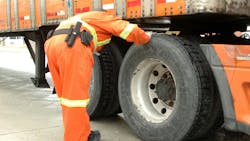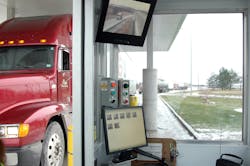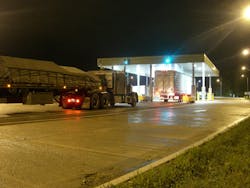Key takeaways:
- Ensure ELD compliance and prevent tampering with hours of service logs.
- Focus on tire safety; drivers should report issues openly.
- Keep regular maintenance practices and communication to address safety year-round.
Roadcheck has a polarizing effect on truck fleets. Some love it and see it as a week-long opportunity to collect windshield decals and rack up clean inspections. Others steer clear of the scales and inspection areas to minimize the chance of getting pulled around back.
The Commercial Vehicle Safety Alliance’s International Roadcheck is May 13-15 this year. A special driver focus is on hours of service—specifically falsification related to electronic logging devices. On the vehicle side, inspectors will pay particular attention to tires: flat tires, air leaks, tread depths, etc., while also checking automatic tire inflation systems.
And, of course, the regular inspection agenda will be in play too, with Level 1 vehicle inspections, driver documentation, Drug & Alcohol Clearinghouse checks, and more.
This is Part One of a two-part series. You can read Part Two here.
Fake driver logs
While ELDs were supposed to address this problem, the falsification of driver logs is apparently rampant.
“We’re seeing a drastic increase in tampering with ELD devices,” Jeremy Disbrow, CVSA’s roadside inspection specialist, said. “We’re trying to raise awareness with inspectors and industry that this is going on and to make sure industry members are checking their logs to make sure that their drivers are not tampering with their devices.”
Falsification is relatively easy to detect during roadside inspections, he said. Following the Electronic Record of Duty Status transfer, inspectors compare time stamps and mileage. They can see mileage jumps where the driver may have unplugged the device, driven some distance, and plugged it back in.
“There are sequence ID numbers included in the printout. If those sequence ID numbers are duplicated or out of order, that could be an indicator that the device has been tampered with,” Disbrow explained. “It doesn’t mean it’s necessarily falsified, but those are red flags that are raised for inspectors.”
Inspectors are also seeing a rise in the use of “fake drivers.”
“We’ve always had fake co-drivers, even with paper logs where the driver says, ‘I just dropped them off at the truck stop an hour ago. You just missed them’,” Disbrow noted. “We’re really trying to dig down into this because we’re finding with ELDs, that a lot of the time the carrier is complicit as well. They’re actually creating fake login accounts for ghost drivers, as we call them.”
Scabby tires
Roadcheck 2025’s emphasis on tires reflects their seemingly permanent ranking in the top 5 vehicle violations. Inspectors will be looking for flat tires, air leaks, cuts and damage to sidewalls, tread depth, etc. As obvious as such defects are to roadside inspectors, they often escape the drivers’ notice. Sometimes, the drivers notice, but fleets say to drive it anyway.
“Sometimes it’s the driver’s fault for not finding violations on their walkarounds, but we also find motor carriers push their drivers, or maybe don’t have a safety mindset, and correct the defects that the drivers do present to them,” Disbrow said. “We’re really trying to change that mindset at the top and hope it works its way down to the drivers.”
Inspectors this year will take a slightly different approach with automatic tire inflation systems, often giving the driver the benefit of the doubt if an inflation issue arises.
“Having a working ATIS gives a little more leeway to the driver or the motor carrier,” Disbrow suggested. “If you have an air leak in the tread, for instance, and you have an automatic tire inflation system that can keep up with your air loss, you’ll be cited for an air leak, but the tire’s not going to be placed out of out of service. “We’re just trying to make sure inspectors are giving drivers the benefit of the doubt when their tires can hold pressure.”
These special focus inspection items, by the way, are decided each year by the International Roadcheck committee, made up of 50/50 industry and enforcement members.
“From the enforcement side, we look back on previous years to see where we’re maybe falling short or could use additional focus,” he said. “From the industry side, committee members throw out ideas based on problems they are having at roadside, as well as what they’re being written up for and would like more education on.”
See also: 2025 International Roadcheck is scheduled for May 13-15
Roadcheck 2025 survival tips
FleetOwner polled a handful of top-drawer fleets to find out how they prepare for Roadcheck. Not surprisingly, they don’t scramble madly in the weeks leading up to the annual inspection blitz to make ready for the eagle-eyed cops. In these cases, it’s business as usual.
Mike Gomes, VP of maintenance at Bison Transport, arguably the safest fleet in North America, said they do not increase scrutiny or maintenance activities leading up to the CVSA Roadcheck event.
“We are fully confident in our current PM programs,” he said. “Our yard teams, including shunt drivers and mobile technicians, work with the drivers on a daily basis to address concerns pre- and post-trip that are shared as they arise.”
In addition to regular communications, Bison advises its team members that the event is happening to raise awareness and to encourage continued discussion on the importance of proper maintenance and operation of all its equipment.
Mike Jeffress, VP of maintenance at Maverick Transport, takes a similar approach. “We do not have any preemptive practices about future inspections,” he said. “Our culture is to do the right thing. If we end up with defects, we dive into what that defect was and how it could have been prevented. That is done monthly when we review our scores.”
Maverick also sends safety messages to the fleet weekly, with a special note if an event like Roadcheck or Brake Safety Week is on the near horizon.
Joyce Sauer Brenny, president and CEO of Brenny Transportation, conducts mock Level 1 inspections with their drivers year-round at the company's St. Joseph terminal to keep maintenance and safety front of mind.
“We have a flashing sign when entering our yard, asking our drivers to stop for a DOT inspection,” she said. “The maintenance team looks at the truck and trailer, while driver support looks through the tractor book, and the safety manager audits the logs.”
Drivers with passing grades are entered into the Grand Champion of Safety award competition with prizes. If they fail the inspection, they get re-trained on the problem issue.
Allen Lowry, VP of safety and risk management at Mesilla Valley Transportation, said safety and compliance is a highly proactive 24/7/365 effort. MVT monitors drivers’ motor vehicle records with an app called Supervision. Anytime their MVR changes, the company gets a notification.
Similarly, the safety department is notified whenever a driver gets a DOT inspection, and the results are uploaded to the federal portal. They are almost instantly aware of the inspection and can coach the driver accordingly.
MVT also uses “quick safety lanes” at its terminals. Any truck returning to the yard gets a proactive once-over by the maintenance staff. Repairs are usually done immediately.
“This is business as usual at MVT. It’s over and above any of these events, like Roadcheck,” Lowry said. “But these events help us sharpen our tools. They provide the opportunity to see where we might have a hole in our system and allow us to fix the problem.”
Disbrow get lots of feedback from the industry on his roadside inspections programs, and most of the questions are centered on what sort of violation will result in a ticket. That should be the least of a fleet’s concern, he said.
“If there’s ever a vehicle or driver violation involved in a fatal collision, that’s something that could get you sued or possibly thrown in prison because of negligence. That’s what you really need to be worried about,” he cautioned.
About the Author

Jim Park
Jim Park is an award-winning journalist who has covered the trucking industry since 1998. Before that, he racked up 2 million miles as an over-the-road truck driver and owner-operator pulling tank trailers. He continues to maintain his CLD. Park's previous driving experience brings a real-world perspective to his work.


